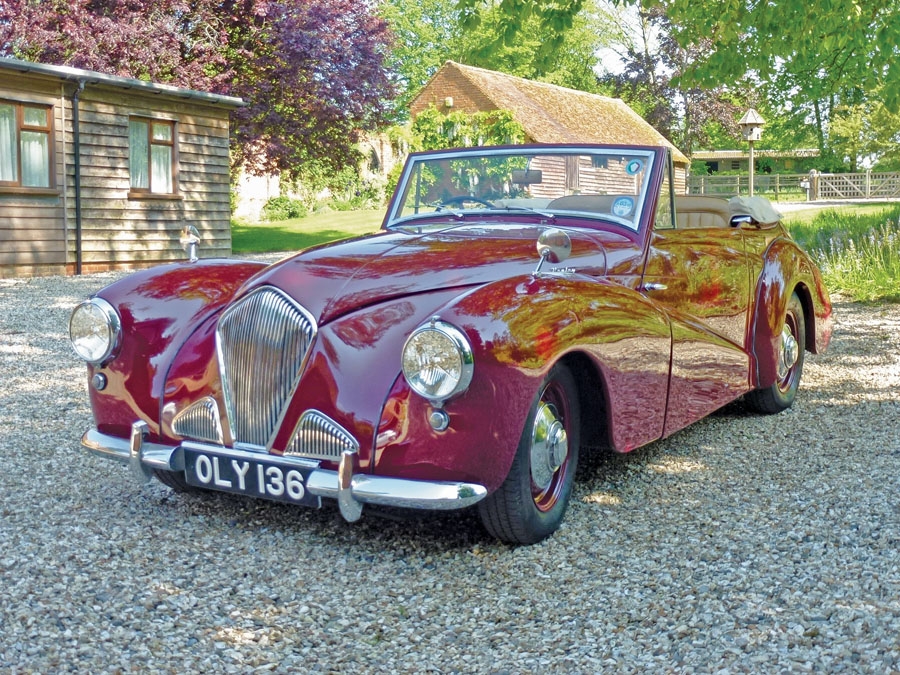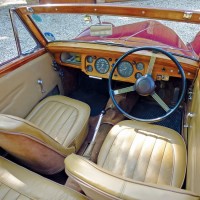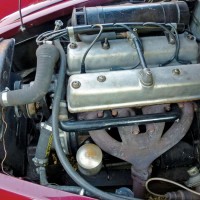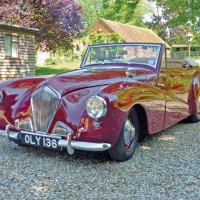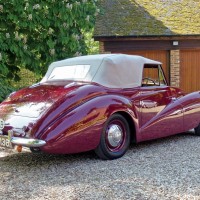SCM Analysis
Detailing
| Vehicle: | 1954 Healey Abbott drophead coupe |
| Number Produced: | 77 (also variously reported as 88 and 91) |
| Distributor Caps: | $25 |
| Chassis Number Location: | Stamped on brass plaque riveted to firewall. Also stamped on the chassis next to the right-hand engine mount |
| Engine Number Location: | Stamped on the same brass plaque as chassis number. Also stamped on the timing chain cover |
| Club Info: | Association of Healey Owners |
| Website: | http://www.healey.dsl.pipex.com/aoho/aoho.htm |
| Investment Grade: | C |
This car, Lot 65, sold for $47,707, including buyer’s premium, at H&H Auctions’ Rockingham, U.K., sale on June 21, 2014.
Immediately after World War II, Donald Healey returned to what he loved: sporting cars. Only this time he founded his own company and began the challenging task of building expensive, limited-production, coachbuilt cars. His business model seemed unlikely to succeed in Britain in the aftermath of a war that had consumed so much of the country’s human and material resources.
Britain’s post-war economy was in dire condition. Almost everything was in short supply. The Donald Healey Motor Company built cars in Quonset huts that had been an old aircraft components factory, and recycling war surplus was a necessity. Parts of his cars may have been shot down by the Luftwaffe — and even common hardware wasn’t common.
How much market could there have been for such cars at that time, especially considering the well-established competition in the market segment? However, while Healey’s company didn’t exactly flourish, it did survive.
Heavy, lumbering cars
The cars they built in these post-war years — and this is before the Austin connection that resulted in the Austin-Healey going into production in 1953 — were, by today’s standards, heavy, lumbering projectiles whose sheer kinetic energy at speed outclassed the brakes and the heart of most drivers. However, the handling was exceptional for the era, and they would cruise at 80 mph all day long. While the steering was heavy, they were otherwise pleasant enough to drive and sportier than their appearance might lead you to believe.
The Abbott was introduced in late 1950 — along with the Tickford — as the second generation of Healey cars. With improved chassis and the addition of Girling brakes, the Tickford was a 2-door, 4-seat sports saloon, and the Abbott was the drophead coupe version — in other words, the convertible.
The start of something special
Healey Abbotts were built until early 1954. During this period, only 77 cars were produced, demonstrating the small company’s limited production capacity — and that it was spread thin with other projects. After all, the Healey Hundred had made its debut at the 1952 London Motor Show, and production of the car as the Austin-Healey 100 began in the spring of 1953. By that time, Healey’s tiny company had turned much of its attention to development and refinement of the 100. Healey also was deeply involved in record-speed attempts on the Bonneville Salt Flats and entries in selected races, such as Le Mans and the Mille Miglia.
As a car aimed at a small-but-wealthy clientele, the Healey Abbott interior appointments were a combination of leather and wool, with walnut on the dashboard and door caps. The driver’s and passenger’s seats were covered in leather and were wide and comfortable, while the rear seat passengers were provided a bench seat that included a center armrest.
The design was at once both dated and uniquely Healey. The skyward ascent of the fender lines and confusion of compound curves combined to reflect a drama of design worthy of England’s medieval cathedrals. This car looked right at home parked next to their flying buttresses. Understatement, that most British quality, was out of place here. England’s post-war upper classes were ready to splurge and indulge in high-speed motoring again, and a dramatic motorcar was just the device needed.
Wood body sprouts trouble
The Abbott, like many of Healey’s post-war designs, was named after the body fabricator, and construction followed the traditional coach-building method of an ash frame with aluminum body panels. Thus restoration and repair are not simple or cheap. Building a new wooden frame will quickly deplete reserves of cash and patience.
Like many of Healey’s cars of the era, the Abbott had a tuned version of the venerable Riley 2.4-liter, 4-cylinder engine producing 104 horsepower at 4,500 RPM — if you dared rev it that high. The engine is a twin cam, but the cams are in the block, not overhead, so it’s also a push-rod motor. Compression was just 6.9:1 even in this “tuned” version, and 0–60 mph was achieved in 14.6 seconds, which was hardly neck-snapping. The engine was still capable of hurtling the car to speeds just “over the ton” — in excess of 100 mph.
This example is reported to be in “good” condition as regards bodywork, paintwork, interior, engine and transmission. Notice that there is no mention of the frame. This car is very attractive — with the exception of the neglected engine compartment.
If the frame is sound, then I call it slightly well bought. If frame repairs are needed, then I call it well sold and wish the buyer stiff upper lip, a deep bank account and plenty of patience. ♦
(Introductory description courtesy of H&H Auctions.)
